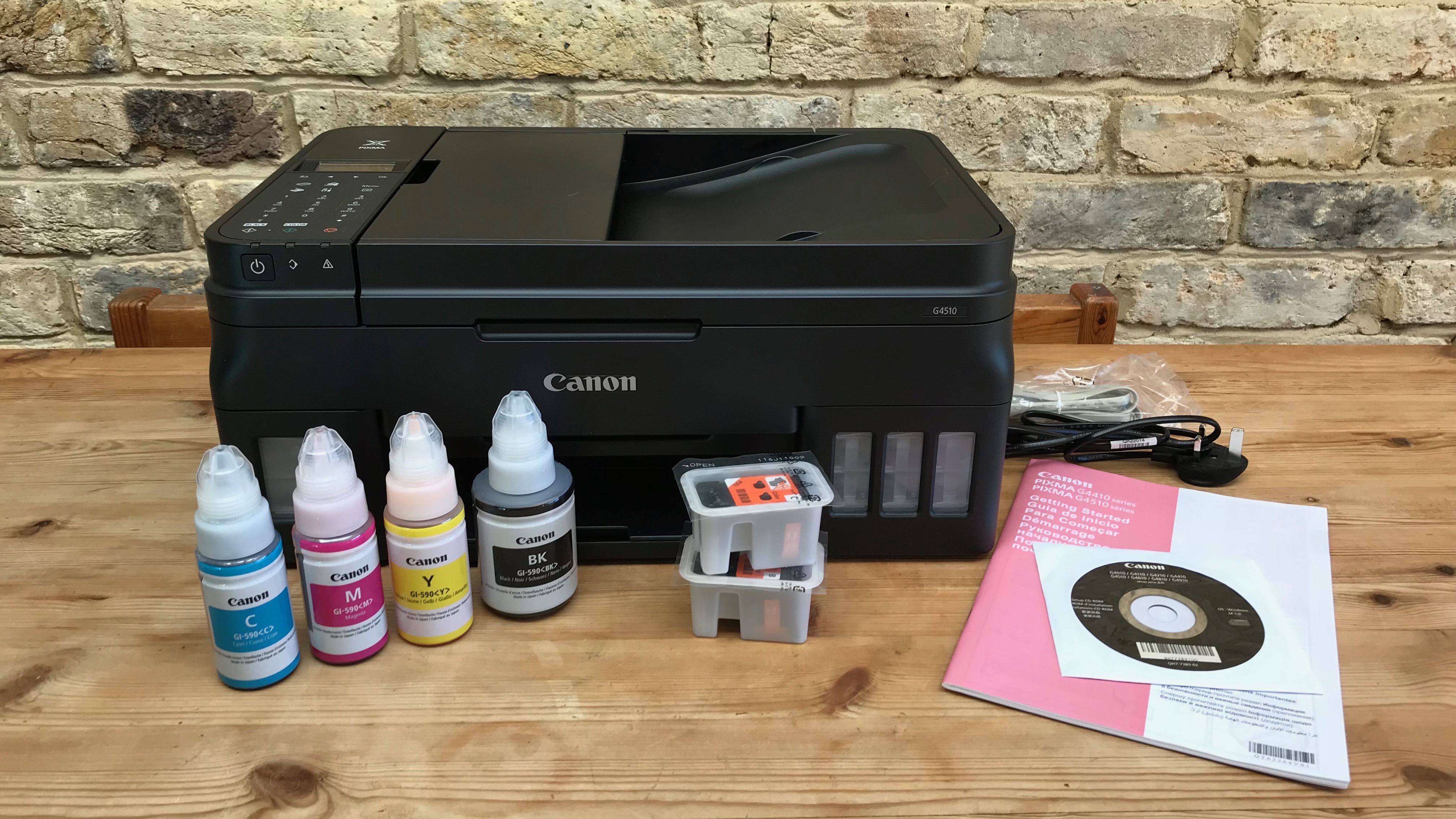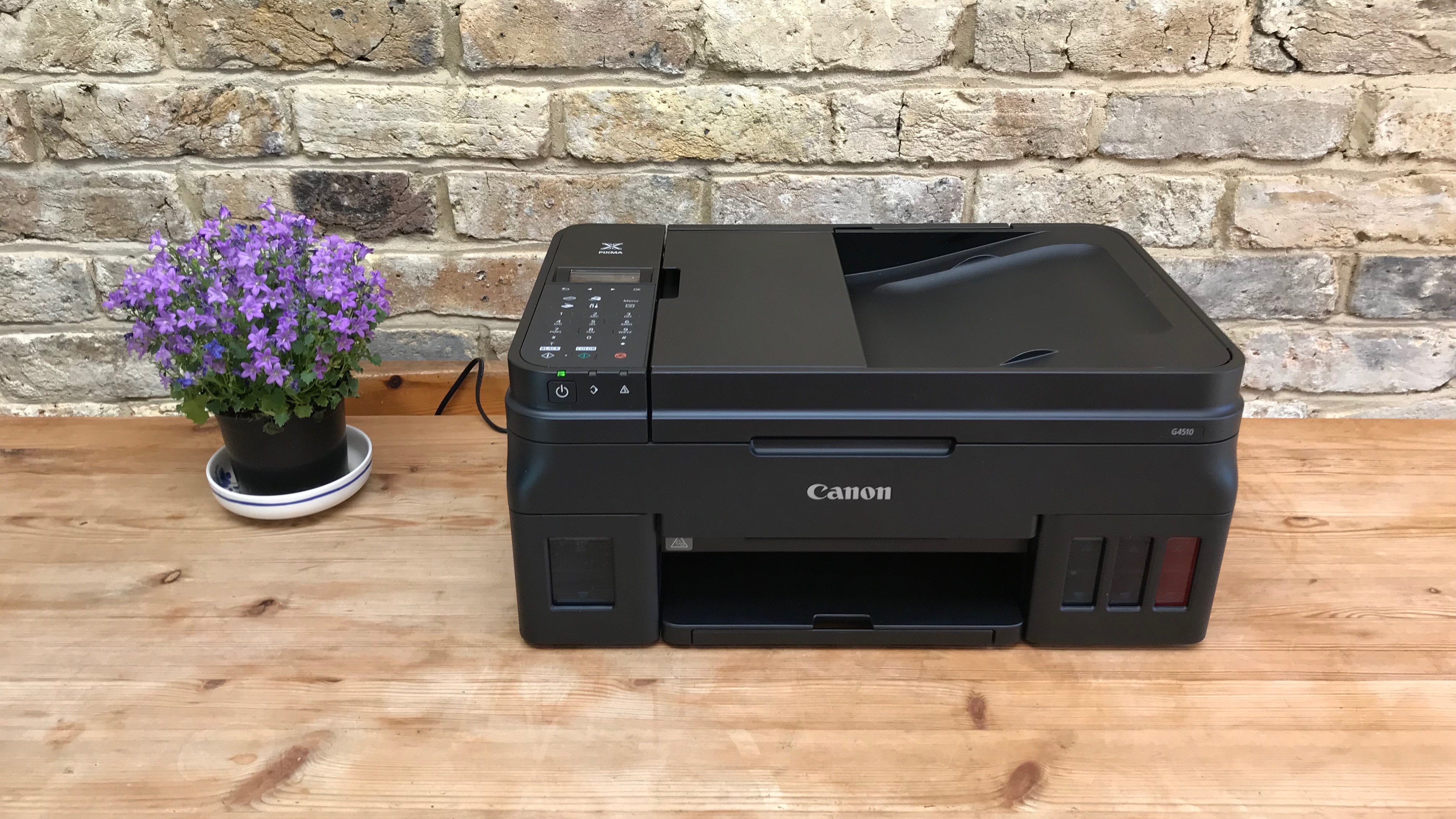TechRadar Verdict
The Pixma G4510 offers very low running costs and this 4-in-1 will suit any small office that needs to print in colour, in any kind of volume.
Pros
- +
Remarkably compact for a 4-in-one
- +
Cost-effective refillable ink system
- +
Strong software and app support
- +
Crisp and natural colour printing
Cons
- -
Photos lack definition and detail
- -
No duplex printing
- -
Potentially messy ink tank system
- -
No front USB or SD card ports
Why you can trust TechRadar
The Pixma G4510 is designed for the small or home office, and Canon has done well to cram so much functionality into such a conveniently compact unit. You can print, scan, copy and fax, as you would expect from a four-in-one, but it also manages to squeeze in a 100-sheet paper tray (at the rear), a two-line display and Wi-Fi.
What’s more surprising is the incorporation of Canon’s new refillable ink-tank system without adding considerably to the overall size. It does add somewhat to the cost, but for the £285 (about US$390, AU$508) this printer comes with enough ink to print 6,000 mono documents and 7,000 colour.
Canon’s solution is not as refined as Epson’s EcoTank system, which has evolved markedly in its second generation, but it is well-implemented here and if the figures are to be believed, the ink bottles are even most cost-effective than Epson’s. You will notice that there are only four tanks (as opposed to Epson’s five, or Canon’s own six-ink cartridge system) and some key features like duplex printing are missing, so in this review we will find out how it compares overall.

Design
The Canon Pixma G4510 is one of the smallest four-in-one devices we’ve tested and the way its ADF and its 100-page paper tray fold away into such a neat oblong box, is rather clever. It means that when not in use, you could slide this MFP into a filing cabinet drawer. Rather than the usual shiny black finish, which tends to attract dust, the G4510 is matte black. Our only concern is that all of the many moving parts feel a little flimsy.

Here are the full specs of the Canon Pixma G4510:
Type: Multifunction colour inkjet printer
Functions: Print, copy, scan, fax
Ink: Four ink tanks (C, M, Y, BK)
Paper size: Up to A4
Connectivity: Ethernet, Wi-Fi, USB
Data storage slot: None
Print speed: 8.8ipm (mono), 5ipm (colour)
Paper tray capacity: 100 sheets
Print quality: 4,800 x 1,200 dpi
Duplex: No
Scan quality: 1,200 x 600 dpi
Apple AirPrint: Yes
Google Cloud Print: Yes
App support: iOS/Android
Consumables included: 4 x 700ml ink bottles
Size/weight: 197 x 445 x 330mm (HxWxD)/7.3kg
Features
Being a 4-in-1 device, you can print, scan, copy and fax, but there are plenty more features. Wi-Fi is built in, for instance, and you can use Wi-Fi Direct instead of a network.
The media tray, as well as holding a surprising amount of plain A4 paper (100-sheets) can also take envelopes, and photo paper of any size up to A4, including Canon’s square photo paper.
For black and white printing, the Pixma G4510 is fairly prompt but by no means fast at a quoted 8.8ipm (imprints per minute), while colour photos take a lot longer. The print resolution is acceptable at 4,800 x 1,200 dpi, though you can find more detail with other printers at a lower price. The scanner resolution is similarly unimpressive at 600 x 1,200.
Sign up to the TechRadar Pro newsletter to get all the top news, opinion, features and guidance your business needs to succeed!
Some key features are missing, so make sure, before you buy, that you won’t be needing to print documents on both sides. The Pixma G4510 cannot duplex print and also, it has no front USB, or SD card slots, which we found pretty inconvenient.
Setup and operation
Setting up the Pixma G4510 is straight forward, and made easier by the helpful videos that are linked to the QR codes in the printed user manual. You wouldn’t usually need to watch a video to get a printer going, but when there are bottles of expensive ink to pour, it’s worth getting all the advice you can find first.

It’s actually a fairly simple case of removing the stoppers from each tank and pouring in the right colour. Obviously you’ll need to get this right to avoid permanently ruining your printer.

Unlike Epson’s EcoTank, where the bottle nozzles correspond and valves prevent you from spilling or overfilling, the Canon system leaves lots of possibility for error. We managed to splash a couple of drops onto the table, leaving what seems to be a permanent stain.

Most features of the Pixma G4510 are very easy to use, but we had a lot of trouble working out how to scan a document for some reason. It’s just not the most intuitive interface and the two-line display is a little frustrating.

Each printer we source for testing is measured on our test bench and the results are critically compared with every other model we have reviewed. Rather than relying on the manufacturer’s quoted figures, we time the first page out and print speeds in single sheet and duplex mode using a standard ten-page document and a stopwatch app. To compare print quality, we print out the same set of test documents on every machine. These twelve test pages include text of varying font sizes and colours, mixed image and text pages, a set of photos and a series of test patterns designed to assess sharpness, colour fidelity, contrast and grey scale.
We also calculate running costs, compare functionality and consider each product’s versatility, design and build quality. The overall score reflects all of these parameters and overall value for money.
Performance
Text documents are thrust out pretty quickly by the Pixma G4510 and they look satisfyingly sharp and well delineated at very small font sizes. We did notice some fluctuation in the amount of ink applied, with some passages looking very slightly lighter than others.
Colour documents appear bold with very well contained colours that showed no signs of smearing or seeping. Photos lack the contrast and vividness of Canon’s six-colour ink system, but it makes the most of the four ink tanks to give quite boldly coloured prints. The Pixma G4510 lacks the resolution to show all the detail in high-resolution images, however, and photos look soft in comparison to those of the Epson EcoTank ET-7750 for example.
Final verdict
This neat 4-in-1 printer brings all of the key features to your office in a desktop-sized unit. Printing is fast enough in terms of mono printing and text remains sharp at very small point sizes. Colour documents look even better with excellent separation between colours and no seeping, or smearing. Despite the size, you can stack one hundred sheets of paper in the rear paper tray, or envelopes, or any size of photo paper including Canon’s 5x5” square paper. Best of all is the low running cost that’s made possible by the refillable ink system, with one set of bottles yielding up to 7,000 colour pages.
To fit all everything in and keep the cost down, the Pixma G4510 has had to forego duplex printing and there are no front USB, or SD card slots. Print quality is somewhat limited by the 4,800 x 1,200 dpi resolution, which is lower than most inkjets at this price point and although the ink system is similarly priced to Epson’s EcoTank bottles, it is not compatible and less refined.
If you need a photo inkjet printer for your home office that can also scan, copy and fax, the Pixma G4510 can do all of that without taking up much room. And although the cost might seem a little high, the refillable ink tank system will begin to save your business money quickly, if you print a lot of documents. It is less sophisticated and lower-specified than it’s rival, the Epson EcoTank ET-7750, but also less expensive and more ink efficient.
- We’ve highlighted the best business printers out there

Jim has been evaluating printers for more than twenty years and has, to date, written over a hundred reviews for TechRadar Pro. From pocket printers to industrial dye sublimation, Jim has been there, run the tests and printed the t-shirt. His expertise extends to consumables (paper, ink, toner) and his printer buying guides make it easy to compare these essential peripherals.
